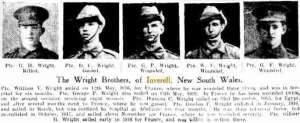
WRIGHT Brothers
Gilbert, George, William, Duncan and Gordon were the sons of William Duncan and Blanche Wright. They were all born in Suffolk, England. By 1911 the family were living near Inverell, NSW.
Duncan was the first of the boys to volunteer for War service. At the age of nineteen he enlisted at Inverell in July 1915. He joined the 7th Light Horse Regiment, 13th Reinforcement and left Australia on HMAT A60 Aeneas in December. He spent a few weeks in Egypt until sent to England and then in December 1916 went to France. He was appointed Lance Corporal in April 1917 and in July became a Corporal. He was gassed in March 1918 and transferred to hospital in England. He returned to Australia in April 1919 and spent the remainder of his life at Inverell where he died in 1964.
Gordon enlisted at Inverell twice. The first time was in August 1915 when he said he was eighteen years old. It is believed he was only fifteen and that his parents had him released from camp. His second enlistment was in September 1917 when his parents gave their permission for him to serve overseas. He left Australia on the ship HMAT Nesta in February 1918 and arrived at Liverpool, England two months later. In July he was sent to France where he was wounded in action the following month. Gordon was invalided back to England and admitted to hospital with a gunshot wound to his leg. He returned to Australia in August 1919 and was medically discharged.
George, aged twenty two, and William, aged twenty one, both enlisted in March 1916, perhaps influenced by the recruiting campaign which saw the large contingents of the Kurrajongs leaving Inverell together. Both men became members of the 36th Battalion, 1st Reinforcement and left Australia on HMAT A74 Beltana in May 1916. After further training in England George was sent to France in July; William went in November.
George was wounded in action in April 1917 and again in August 1918 when he was invalided back to England and admitted to the Royal Victoria Hospital at Netley. He returned home in March 1919 and was medically discharged.
William was wounded in action in January 1917 and returned to England for treatment of a gunshot wound to his back and leg. He returned to France four months later. By April 1918 he had been transferred to the 33rd Battalion. He became ill and was invalided back to England in August and admitted to the same hospital as George. He returned to Australia in January 1919. William died at Inverell in February 1921.
With the permission of his parents, Gilbert enlisted at Inverell in January 1917 when he was eighteen years old. He joined the 36th Battalion, 7th Reinforcement and left Australia on HMAT A24 Benalla in May. Although he arrived in England in July he did not go to France until April 1918 due to health issues. He was transferred to the 33rd Battalion before being wounded in May. He rejoined his unit and was killed in action near Bray on 22 August 1918. Private Gilbert Wright was buried at Bray Vale British Cemetery, France. A memorial service was held for him at the Inverell Anglican Church in October 1918.
The names of the Wright brothers are all recorded on the oak panelled Honor Roll at St Augustine’s Anglican Church, Inverell, unveiled by their Mother in May 1919. Their names are also recorded on the Inverell Honor Roll. Gilbert’s name is inscribed on the Gilgai and Inverell Cenotaphs and in 1919 he was one of the men for whom a memorial tree was planted in Kurrajong Parade.
Photo: The Wright Brothers, courtesy Sydney Mail newspaper 22 January 1919
